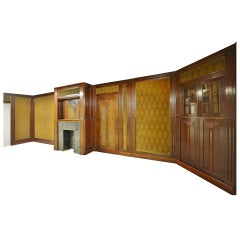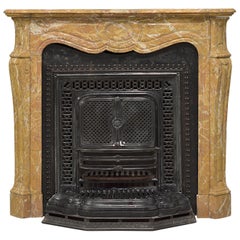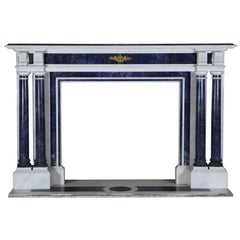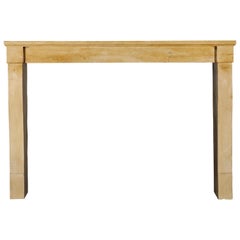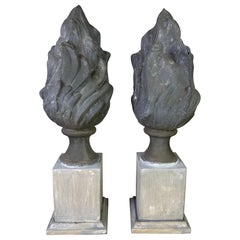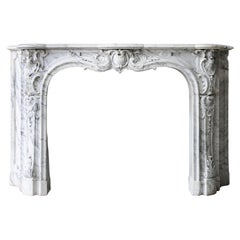European Architectural Elements
to
473
1,819
612
2,275
162
20
Height
to
Width
to
184
140
124
120
103
89
78
72
66
65
55
35
34
19
13
12
6
4
659
972
644
182
208
215
132
27
5
54
34
18
32
50
47
3
5
990
675
619
569
287
2,457
901
570
551
510
2,457
2,332
2,397
60
35
20
15
14
Place of Origin: European
Mahogany and Fabric Panelled Room, Designed by Jac. van den Bosch
By Jac van den Bosch
Located in Haarlem, Noord-Holland
A rare opportunity to acquire this exquisite panelled room with original wall fabric, circa 1912.
This room was designed by Jac. van den Bosch (1868-1948), the wall fabric was design...
Category
20th Century European Architectural Elements
Materials
Fabric, Mahogany
Antique Marble Fireplace with Cast Iron Stove
Located in Haarlem, Noord-Holland
Amazingly colorful French Louis XV fireplace mantel from Paris, France.
This bright and friendly pompadour style mantel comes with cast iron stove and...
Category
19th Century Louis XV Antique European Architectural Elements
Materials
Marble, Breccia Marble
Blue and White Statuary Marble Antique Fireplace Surround
Located in Beervelde, BE
This amazing, one of a kind fireplace mantel, surround is in perfect condition; it was made by special order for a Parisian salon (France). It is crafted from white statuary marble w...
Category
Late 19th Century Other Antique European Architectural Elements
Materials
Statuary Marble
19th Century Fine European Antique Fireplace Surround
Located in Beervelde, BE
This is a nice French honey color limestone antique fireplace surround. The waxed surface of the antique chimney piece has a silky feeling when t...
Category
Early 19th Century Country Antique European Architectural Elements
Materials
Limestone
Pair of 19th C. Zinc Flames on Wood Bases
Located in Los Angeles, CA
This pair of 19th-century finials features sculptural flame motifs cast in metal, likely zinc, known for its durability and weather resistance. Each flame form rises organically with...
Category
19th Century Classical Roman Antique European Architectural Elements
Materials
Zinc
$720 Sale Price / set
20% Off
Antique Marble Fireplace Arabescato Marble 19th Century Monumental
Located in Made, NL
Exceptional, impressive and monumental 19th century antique fireplace surround in beautiful Arabescato marble.
The carving is in superb quality showing the high standard and exceptional craftsmanship of its sculpturer. This unique antique chimneypiece mantle is a one in its kind
The style of this antique mantle...
Category
19th Century Louis XV Antique European Architectural Elements
Materials
Marble
Early Spanish 17th C. Porto Santos with Original Polychrome Paint and Columns
Located in Round Top, TX
Very rare and early Spanish Porto Santos “Door of the Saints” Altarpiece with 12 carved columns and original gilt and polychrome paint. This is typical piece to be seen in the Cathol...
Category
Late 17th Century Antique European Architectural Elements
Materials
Wood
Alvar Aalto Sculptural Aluminium Door Handles
By Alvar Aalto
Located in Turku, Finland
Sculptural Door Handles designed by Alvar Aaltos. Made in Finland.
Material: Alumininum
Includes two handles and spacer. No connecting screws / rose screws.
Category
1980s Mid-Century Modern Vintage European Architectural Elements
Materials
Metal, Aluminum
$1,032 Sale Price
30% Off
Exceptional 18th Century Oak Boiserie Panel from Chateau Saint-Maclou, Normandy
Located in Dallas, TX
This fabulous hand-carved boiseries or wooden panel was recently purchased from the Chateau St. Maclou in Normandy, France. Rooms of boiseries had design motifs that were kept the same throughout the entire area that was paneled. For instance, on this panel, there are mainly acanthus leaf motifs used in various areas. A medieval lion...
Category
1750s Antique European Architectural Elements
Materials
Oak
Pair Italian 18/19th Century Hand Carved Giltwood Acanthus Leaf Curl Ornaments
Located in Buisson, FR
Beautiful handcarved giltwood acanthus leaf curl ornaments that once adorned a chapel .Original period pieces that due their high age have a wonderful weathered look.
Italy circa 178...
Category
18th Century Antique European Architectural Elements
Materials
Wood
$466 Sale Price / set
50% Off
1 of the 60 White and Blue Art Deco Glazed Tiles by Le Glaive, Belgium
By Le Glaive
Located in Rijssen, NL
Handmade tiles in white and blue glazed color. With a beautiful fine star-like illustration . Manufactured around 1920 by Le Glaive, Belgium.
These tiles would be charming displayed ...
Category
Early 20th Century Art Deco European Architectural Elements
Materials
Ceramic
19th Century Gilt Wood Fragment Architectural Sculpture, France
Located in Haddonfield, NJ
French Gilded Wood Rococo Wall or Table Fragment.
Beautiful period Rococo design constructed in gilt wood featuring intricate scroll motifs throughout as well a small old mirrored ...
Category
Early 19th Century Rococo Antique European Architectural Elements
Materials
Wood, Giltwood
Architectural Push and Pull Bronze Door Handle Square with matching Bell
Located in London, GB
Pair of square bronze push and pull door handles and matching bell with central horizontal border of Brutalist relief creating a stunning detail to the door. They can be mounted on a...
Category
1970s Mid-Century Modern Vintage European Architectural Elements
Materials
Bronze
Pair Large Gothic Revival Wall Brackets or Corbels w. Beautifully Roses & Lilies
Located in Lisse, NL
These stunning display brackets or consoles are unique in size and design.
We have sold our share of wall brackets over the years, but this recently ...
Category
Early 20th Century Gothic Revival European Architectural Elements
Materials
Wood, Oak
Early 20th Century Antique Wood Door with Iron Panels and Glass Door Panels
Located in Stamford, CT
Early 20th Century antique wood entrance door with decorative iron panels and two opening glass door panels. This is a great door salvaged from ...
Category
Early 20th Century European Architectural Elements
Materials
Iron
$3,160 Sale Price
20% Off
Panel with glass porthole - 1960 Jean Prouvé - Studal
By Jean Prouvé
Located in Paris, FR
Very rare Panel with glass porthole - 1960 Jean Prouvé - Studal
.
Self-supporting porthole bin.
.
Aluminium and glass.
.
Saint Egreve technical building/ architect Gutton
.
Dimension...
Category
1960s Vintage European Architectural Elements
Materials
Aluminum
Pair of 1880s Italian Carved Wooden Wall Carvings Depicting Pomegranates
Located in Atlanta, GA
A pair of Italian carved wooden wall carvings from the late 19th century, depicting pomegranates. Created in Italy during the last quarter of the 1...
Category
Late 19th Century Antique European Architectural Elements
Materials
Wood
Dutch 19th Century Carved Mahogany Transom
Located in Baton Rouge, LA
A dramatic frame of carved mahogany found in the Netherlands, likely a 19th century architectural detail such as a transom above a doorway. This pierced window is without glass allow...
Category
19th Century Georgian Antique European Architectural Elements
Materials
Mahogany
Antique Large English Wrought Iron and Gilt Bronze Lantern, circa 1910s
Located in Douglas Manor, NY
This wrought and pierced iron lantern has gilt accents. The ornate scrolls are enhanced by the gilt work. Six light.
Needs rewiring
Category
Early 20th Century European Architectural Elements
Materials
Iron, Ormolu
Antique French Industrial Roman Numeral Clock Face, 20th Century
Located in Palm Desert, CA
Evoking the grandeur of European railway stations and bell towers, this antique French industrial clock face features a bold openwork ...
Category
Early 1900s Industrial Antique European Architectural Elements
Materials
Sheet Metal
Solid Axel-Vervoordt Style Fireplace Original Reclaimed Base Stone In Limestone
Located in Beervelde, BE
This solid base stone is a striking piece of off-white French limestone, perfect for those who appreciate the timeless elegance of Axel Vervoordt’s aesthetic. The rectangular, reclai...
Category
18th Century French Provincial Antique European Architectural Elements
Materials
Stone, Limestone
Antique Marble Fireplace of Portoro Marble, 19th Century, Louis XV Style
Located in Made, NL
A rare antique marble fireplace from ancient Portoro marble from Tuscany. Portoro marble is one of the most elegant Italian marbles. The black background with golden veins ensures lu...
Category
19th Century Louis XV Antique European Architectural Elements
Materials
Marble
$23,342 Sale Price
20% Off
French Style Wrought Iron Greenhouse with Door and Windows in White Color
Located in Marbella, ES
French style wrought iron greenhouse with doors and windows that open outwards. Ready for glass panels to be installed.
Category
2010s European Architectural Elements
Materials
Iron
Gustavian Neoclassical 18th Century Pedestal, Origin: Sweden, Circa 1780-1795
Located in New York, NY
Gustavian, neoclassical 18th century pedestal, origin; Stockholm, Sweden, circa 1780 - 1795, with exceptionally painted, all original faux-marble finishes
Provenance: Private Collec...
Category
18th Century Gustavian Antique European Architectural Elements
Materials
Wood, Paint
Pair of 19th Century Antique Decorative Bronze Panels
Located in Stamford, CT
An amazing pair of antique 19th Century highly decorative bronze panels. This is a beautiful pair of cast bronze wall or door panels with openwork details with urns and floral designs. The backs are flat which could have been used in a wall vent...
Category
Late 19th Century Antique European Architectural Elements
Materials
Bronze
Pair of 19th C. Italian Stone Artichokes
Located in Los Angeles, CA
Pair of 19th century weathered stone artichoke finials. They are all hand chiseled and have bulbous shapes with a layered, petal-like pattern coverin...
Category
19th Century Classical Roman Antique European Architectural Elements
Materials
Stone
$1,200 Sale Price / set
50% Off
Impressive Wooden Stair Newel Post or Display Pedestal with Carved Lion Heads
Located in Lisse, NL
Great, sculptural stair newel post from the 1800s.
This unique newel post and pedestal is beautifully and richly carved all around. Most impressive ...
Category
Mid-19th Century Neoclassical Revival Antique European Architectural Elements
Materials
Wood
Exquisite Classic French Antique Limestone Fireplace Surround
Located in Beervelde, BE
This fine Louis XVI antique fireplace surround in French limestone is in great condition.
Original and one of a kind mantle, a real work of art, with floral details on the front of ...
Category
Late 18th Century Louis XVI Antique European Architectural Elements
Materials
Limestone
Exceptionally Rare 19th Century Cast Brass Adjustable Fender
Located in Dublin, IE
An exceptionally rare and fine 19th Century fully restored cast brass adjustable fender in the Neoclassical manner. The pierced frieze with flowerhea...
Category
19th Century Antique European Architectural Elements
Materials
Brass
19th Century Bronze Bell with Zinc Cupola
Located in Winter Park, FL
A 19th century French cupola from a rooftop belfry housing a cast bronze bell. Cupola has wrought iron frame with zinc roof. Bell hangs from wood yoke and has a 36" long pull chain a...
Category
19th Century French Provincial Antique European Architectural Elements
Materials
Bronze, Iron, Wrought Iron, Zinc
Large Hand Forged Wrought Iron Candle Chandelier for Dining Room, Restaurant Etc
Located in Lisse, NL
Museum quality, forged in fire, Medieval castle-design chandelier.
This excellent quality AND condition pendant is all hand-forged and its design and perfect execution lifts it abov...
Category
Late 19th Century Arts and Crafts Antique European Architectural Elements
Materials
Wrought Iron
Antique Fireback, Small and Decorative
Located in Haarlem, Noord-Holland
A nicely decorated gem of a fireback or backsplash, displaying a monkey and cat playing in a fireplace mantel.
Hollow casted so its relatively light, would make a great wall decor...
Category
Late 19th Century Louis XVI Antique European Architectural Elements
Materials
Iron
$544 Sale Price
20% Off
Pair of Antique French Renaissance Style Carved Wood Architectural Wall Panels
Located in Houston, TX
Great pair of well carved French Renaissance style or French Baroque style relief carved architectural walnut wooden panels or fragments from the 19th century.
These beautifully carv...
Category
19th Century Greco Roman Antique European Architectural Elements
Materials
Wood
Authentic French Rouge Griotte Marble Fireplace Surround
Located in Beervelde, BE
A beautiful French Louis XIV period, 18th century, original mantle piece in Rouge Griotte marble.
The marble was used in lots of historical landmarks in...
Category
18th Century Louis XIV Antique European Architectural Elements
Materials
Griotte Marble
Pair of 19th Century Swedish Diamond Pattern Doors
Located in Atlanta, GA
A pair of Swedish doors with geometric patterns and original paint from the 19th century. This pair of antique doors from Sweden feature a repeating diamond pattern, comprised of a s...
Category
19th Century Antique European Architectural Elements
Materials
Iron
Antique Carrara marble fireplace in Pompadour style, 19th century
Located in Made, NL
This elegant antique fireplace, made of refined Carrara marble, comes from France and exudes the charm of the 19th century. With graceful lines and subtle details, it is a timeless v...
Category
19th Century Other Antique European Architectural Elements
Materials
Marble
1 of 52 Handmade Antique Ceramic Tiles by Devres, France, 1920s
By Devres
Located in Rijssen, NL
One of 52 antique French handmade ceramic tiles. Manufactured by Devres, circa 1920s. Colorful pattern in yellow, red and green. These tiles would be charming displayed on easels, fr...
Category
1920s Folk Art Vintage European Architectural Elements
Materials
Ceramic
Classic French Antique Fireplace Surround in Royal Breche D'aleppo Marble
Located in Beervelde, BE
Exclusive antique fireplace surround in the richly colored Royal Breche D’ Aleppo marble. This mantel is in perfect condition. You feel the hand of the maker when you run your finger...
Category
Early 19th Century Louis XIV Antique European Architectural Elements
Materials
Marble
Hand Carved Stone Limestone Simple Rustic Fireplace Mantle Surround Antiques CA
Located in West Hollywood, CA
Hand Carved Stone Limestone Simple Rustic Fireplace Mantle Surround Antiques CA. A nicely Hand finished carved simple white and off white limestone fireplace mantel (fireplace) surro...
Category
21st Century and Contemporary Louis XVI European Architectural Elements
Materials
Stone, Limestone
Antique 18th Century Door Lock Gilt and Chiseled Bronze, France, Louis XVI
Located in Firenze, IT
This precious lock in mercury-gilt bronze and meticulously chiseled with sphinxes and leaf motifs dates back to the 18th century, Louis XVI period.
It probably served the door of an ...
Category
18th Century Louis XVI Antique European Architectural Elements
Materials
Bronze, Ormolu
Two Italian Brass Door Pulls
Located in Hanover, MA
Two 1960's Italian door pulls in solid brass in the form of stylised wings or feathers.
New Old Stock.
NOTE: Both are RIGHT hand orientation unless one is inverted; these are not a ...
Category
1960s Mid-Century Modern Vintage European Architectural Elements
Materials
Brass
$1,590 / set
French Style Wrought Iron Greenhouse with Door and Windows in Green Color
Located in Marbella, ES
French style wrought iron greenhouse with doors and windows that open outwards in white color. Ready for glass panels to be instal...
Category
2010s European Architectural Elements
Materials
Iron
Italian 16th/17th Century Small Iron Door Depicting Saint George
Located in Buisson, FR
Amazing period piece.
Beautiful small iron door that most likely once had its place in an Italian Chapel.
It is depicting Saint George killing the dragon. Beautiful naive style.
Ital...
Category
17th Century Antique European Architectural Elements
Materials
Iron
$2,891 Sale Price
38% Off
Pair of 1930's Italian Brass Door Pulls
Located in Hanover, MA
Pair of charming Italian art deco polished brass door pulls
Category
1930s Art Deco Vintage European Architectural Elements
Materials
Brass
$1,395 / set
Set of Impressive Mid-Century Modern French Parlour Doors
Located in Brooklyn, NY
Large French architectural doors with charming detailing. Over nine feet tall, can be used as a long room divider.
(Please confirm item location -...
Category
Early 20th Century European Architectural Elements
Materials
Wood
$3,360 Sale Price / set
37% Off
Three 1950's Italian Door Pulls with Abstract Expressionist Design
Located in Hanover, MA
We have three of these chic mid-century Italian door pulls made of melamine with cast brass hardware with an abstract expressionist design lithograph transferred onto the plate.
Pric...
Category
1950s Mid-Century Modern Vintage European Architectural Elements
Materials
Brass
double capital - french, end of 13th century
Located in Bruxelles, BE
Double capital with hook decorations
Grey stone
France, 13th century
Reduced—cut in the back in modern times
H 22 x L 41 x P 20 cm
'Hook' is the name given today to these ornamen...
Category
15th Century and Earlier Medieval Antique European Architectural Elements
Materials
Stone
$1,652 Sale Price
22% Off
Early 20th Century English Bronze Ship’s Bell
Located in Worcester, GB
Early 20th Century English Bronze Ship’s Bell
A finely cast English ship’s bell dating to the early 20th century, circa 1910–1930. Executed in solid bronze w...
Category
Early 20th Century European Architectural Elements
Materials
Bronze
Jean Prouve Facade element in enamal France 1965
By Jean Prouvé
Located in Roosendaal, Noord Brabant
Rare facade element by Jean Prouve, designed for the André-Argouges high school, Grenoble France 1965. Made of enamelled metal with isolation inside. A...
Category
1960s Mid-Century Modern Vintage European Architectural Elements
Materials
Enamel
Circular Push-Pull Door Handle in Bronze, Mid-20th Century, France
Located in London, GB
Circular push-pull door handle in bronze (or brass), mid-20th century, France.
A very simple elegant handle, made up of two separate pieces - each side with a slightly concave dish ...
Category
Mid-20th Century Mid-Century Modern European Architectural Elements
Materials
Bronze
Rare Olympic games prefab Munich 1972 by Peter Hübner
By Another Human
Located in Perpignan, FR
CASANOVA. 1972
by Gallery Clément Cividino Ent.
HISTORIQUE
A l'occasion des jeux olympiques de Paris 2024 , notre galerie présente en exposition pour son rendez vous estival au domaine viticole Terra Remota une capsule habitable modulaire appelée Casanova. Ces capsules modulaires polyèdres ont une superficie de 9m2. De fabrication économique et légères, elles étaient utilisées temporairement pour des infrastructures d'accueil et logements temporaires. L’exemplaire que nous présentons servait à l’accueil des athlètes pour les jeux olympiques de Munich 1972.
Dessinée au début des années 70 par l’architecte Allemand Peter Hübner...
Category
1970s Space Age Vintage European Architectural Elements
Materials
Fiberglass, Polyester, Polystyrene
Antique fireplace in style of Louis XVI, noir de mazy marble, 19th century
Located in Made, NL
This timeless elegant 19th century fireplace is made of the rare marble Noir de Mazy marble, the deep black Belgian marble known for its luxurious appearance. Executed in the refined...
Category
19th Century Louis XVI Antique European Architectural Elements
Materials
Marble
Antique Spanish Wall Pediment 'or Headboard' w/Original Floral-Painted Finish
Located in Atlanta, GA
A Spanish carved-wood wall hanging pediment with it's original painted finish from the 19th century. This antique wooden architectural pl...
Category
19th Century Antique European Architectural Elements
Materials
Wood
Antique Elephant Doorstop, English, Great Exhibition, Door Keeper, Victorian
Located in Hele, Devon, GB
This is a delightful antique elephant doorstop. An English, handpainted cast iron decorative door keeper or mantel ornament, dating to the early Victorian period, circa 1850. A fine ...
Category
1850s Early Victorian Antique European Architectural Elements
Materials
Iron
French Directoire Period Floral Painted Panel in Gilded Frame, circa 1790
Located in Atlanta, GA
A French Directoire period framed painted panel from the late 18th century, with floral motifs. Born in France during the later years of the 18th century, this exquisite decorative p...
Category
Late 18th Century Directoire Antique European Architectural Elements
Materials
Wood, Paint
English Renaissance Carved Oak Paneled Room
Located in Queens, NY
English Renaissance (Tudor-16th Century) oak carved linen fold design paneled room with a mantle, overmantle carving and a Pair of spindle design open doo...
Category
16th Century Gothic Antique European Architectural Elements
Materials
Oak
Bronze Push-Pull Handle with Abstract Modernist Design, 20th Century
Located in London, GB
An unusual square push-pull door handle made of patinated bronze featuring a raised modernist design of overlapping loosely geometric shapes. 20th century design, found in Germany.
...
Category
20th Century Mid-Century Modern European Architectural Elements
Materials
Bronze
HUGE Pair of 13-Light Handforged Wrought Iron Castle Chandeliers w. Gothic Crown
Located in Lisse, NL
Largest ever pair of Medieval Style chandeliers, over 5 feet tall.
With 20th century lighting as one of our specialities we have seen and sold all kinds of light fixtures, but never...
Category
20th Century Medieval European Architectural Elements
Materials
Wrought Iron, Metal
Huge Spanish Neoclassical Alabaster Urn Table Lamp with Winged Dragons
Located in Barcelona, ES
One of a kind Carved Alabaster Urn Lamp with Winged Dragon Handles, Spain, 1930s
This stunning Art Deco period alabaster lamp has an elegant neoclassical urn design with foliage carv...
Category
20th Century Neoclassical European Architectural Elements
Materials
Alabaster
19th Century Fireplace in Style of Louis XVI of Blue Fleuri Marble
Located in Made, NL
A beautiful 19th century Blue Fleuri marble fireplace in the style of Louis XVI. A straight model with many fluting in the front part and continuous on the legs! The dimensions are a...
Category
19th Century Louis XVI Antique European Architectural Elements
Materials
Marble
$10,170 Sale Price
20% Off
Recently Viewed
View AllMore Ways To Browse
Chinese Green Tiles
Copper Corbels
Figural Corbels
French Devres Tile
French Wrought Iron Railing
Gothic Salvage
Indian Shutters
Iron Window Grille
Large Garden Mirrors
Limestone Gargoyle
Limestone Pillars
Marble Seashell
Pair Door Knockers
Spanish Wood Beam
Stone Carved Keystone
Stone Caryatid
Talavera Tiles
Terra Cotta Finial
